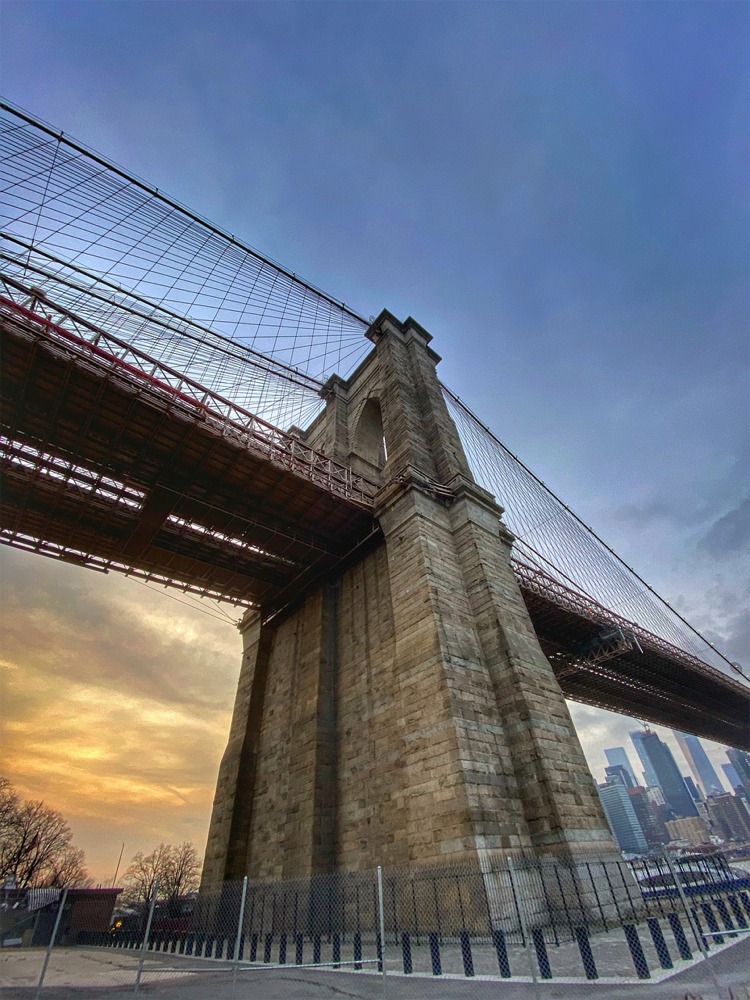Brooklyn Bridge Pier
Home > New York State Photographs > New York > Brooklyn Bridge Pier

The Brooklyn Bridge pier was a sight to behold as the sun set over the East River. The pale orange and blue hues of the sunset created a stunning backdrop for the imposing structure, its steel cables glinting in the waning light. The bridge itself was a remarkable feat of engineering - a symbol of progress and a portal for many of New York's citizens who wished to span the waters between Manhattan and Brooklyn.
On this particular evening, the bridge was alive with activity: people walking leisurely across its pedestrian deck, couples posing for romantic photographs, small children pointing up at the sweeping arches, and teens taking selfies or talking excitedly together. Even the pigeons appeared to be enjoying the spectacle, swooping and circling around the bridge before settling on its highest point.
But even with all this commotion, the bridge was still a place of solace and peacefulness. Standing beneath the bridge the photographer felt a deep sense of awe and admiration for the bravery and ingenuity of its creators. At that moment, he fully appreciated the bridge not only as a marvel of technology but also as a symbol of resilience and hope.
Brooklyn Bridge
The Brooklyn Bridge is an iconic landmark that spans the River, connecting the boroughs of Manhattan and Brooklyn in New York City. It is one of the oldest suspension bridges in the United States and has become a symbol of the city's engineering prowess and architectural beauty. Here's some information about the Brooklyn Bridge:
Construction
The construction of the Brooklyn Bridge began in 1869 and was completed in 1883. It was designed by the architect John A. Roebling, with assistance from his son Washington Roebling and his son's wife Emily Warren Roebling. The bridge's construction faced various challenges, including the use of caissons (large watertight chambers) for the bridge's foundations and the implementation of steel cable suspension technology.
Architecture and Design
The Brooklyn Bridge showcases a combination of Gothic and neo-Gothic architectural styles. It features two towers made of granite, limestone, and cement, connected by steel cables and suspension cables. The bridge has a total length of approximately 6,016 feet (1,834 meters) and a main span of 1,595.5 feet (486.3 meters), making it an impressive engineering feat of its time.
Function and Transportation
The Brooklyn Bridge serves as a vital transportation link between Manhattan and Brooklyn. It carries vehicular traffic, pedestrians, and cyclists. The bridge has two designated roadways for vehicles running in either direction, as well as an elevated walkway for pedestrians. It offers stunning views of the Manhattan skyline, the River, and the surrounding areas.
Landmark and Symbolism
The Brooklyn Bridge is recognized as a National Historic Landmark and has immense cultural significance. It represents the ingenuity and progress of New York City and has been featured in numerous films, literature, and artworks. The bridge is often associated with the American Dream and serves as a symbol of unity and connectivity.
Pedestrian Experience
Walking across the Brooklyn Bridge is a popular activity for both locals and tourists. The elevated walkway provides pedestrians with a scenic pathway to enjoy panoramic views of the city. Along the way, there are historical plaques and benches where visitors can rest and take in the surroundings.
Cultural and Social Importance
The Brooklyn Bridge has played a significant role in shaping the cultural fabric of New York City. It has inspired artists, writers, and photographers who have captured its grandeur and significance. The bridge has also been a site for public gatherings, celebrations, and demonstrations, reflecting its role as a symbol of civic pride and resilience.
The Brooklyn Bridge stands as an iconic landmark, a testament to human engineering and a cherished part of New York City's history. It continues to captivate and inspire people from around the world, attracting millions of visitors who come to admire its beauty and experience its unique charm.


